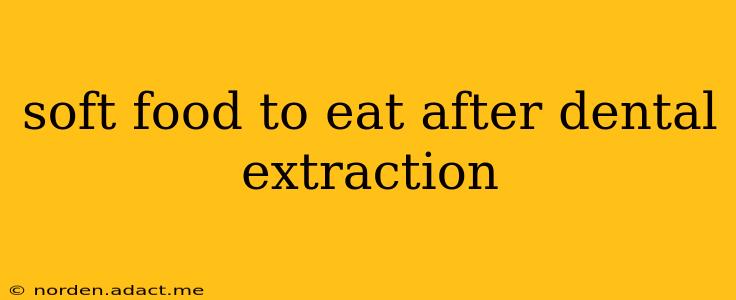Having a tooth extracted can be uncomfortable, and choosing the right foods afterward is crucial for a smooth recovery. This guide explores the best soft foods to eat after dental extraction, addressing common concerns and offering practical tips for a comfortable post-operative experience. We'll also tackle some frequently asked questions to ensure you're fully informed.
What are the best soft foods to eat after a tooth extraction?
The key is to choose foods that are easy to chew and won't irritate the extraction site. Think smooth, cool, and nutrient-rich options. Excellent choices include:
- Yogurt: A fantastic source of protein and calcium, crucial for healing. Opt for plain yogurt and add a touch of honey or fruit for sweetness.
- Applesauce: A classic soft food that's gentle on the gums. Choose unsweetened varieties for better health.
- Oatmeal: Cooked oatmeal is easily digestible and provides essential energy. Avoid adding crunchy toppings initially.
- Smoothies: Blend fruits, vegetables, and yogurt for a nutrient-packed and easy-to-consume meal.
- Mashed potatoes: A comforting and nutritious option, easily customized with herbs and spices.
- Scrambled eggs: A good source of protein, but ensure they are well-cooked and soft.
- Soups (broth-based): Choose clear broths or pureed soups to avoid irritating the extraction site. Avoid soups with chunky ingredients.
- Pudding: Provides a creamy and easy-to-swallow texture. Opt for low-sugar varieties.
What should I avoid eating after a tooth extraction?
Certain foods can hinder healing and cause discomfort. It's essential to avoid:
- Anything crunchy: Chips, nuts, crackers, and popcorn can dislodge the blood clot forming in the extraction site, leading to a painful condition called dry socket.
- Foods requiring vigorous chewing: Steaks, tough meats, and raw vegetables should be avoided until the healing process is well underway.
- Hot foods: Hot foods can increase inflammation and bleeding.
- Acidic foods: Citrus fruits and juices can irritate the extraction site.
- Alcohol and smoking: These substances can interfere with blood clotting and healing.
How long should I eat soft foods after a tooth extraction?
Generally, you should stick to a soft food diet for at least the first few days, or as advised by your dentist or oral surgeon. As healing progresses, you can gradually reintroduce firmer foods. Your dentist will provide a personalized timeline based on your individual case and the complexity of the extraction.
What if I have difficulty eating soft foods?
If you're finding it challenging to consume enough nutrients with a soft food diet, consider nutrient supplements. Speak with your dentist or doctor about the possibility of adding nutritional shakes or supplements to your routine to ensure you receive adequate nutrition during your recovery.
Can I eat ice cream after a tooth extraction?
While the cold temperature of ice cream can temporarily numb the pain, it's generally recommended to limit your intake. The sugar content can contribute to bacterial growth, and the cold can sometimes cause sensitivity. Enjoy it in moderation and only once the immediate post-extraction phase has passed.
What are some tips for eating comfortably after a tooth extraction?
- Eat small, frequent meals: This will help prevent strain and discomfort.
- Eat slowly and carefully: Take your time chewing to avoid putting pressure on the extraction site.
- Keep the area clean: Rinse your mouth gently with saltwater after meals to maintain hygiene.
- Follow your dentist's instructions carefully: Your dentist's advice is crucial for successful healing.
By carefully selecting your post-extraction diet and following your dentist's recommendations, you can ensure a smooth and comfortable recovery. Remember, patience and proper care are key to a successful healing process. Always consult with your dentist or oral surgeon if you have any concerns or questions regarding your post-extraction diet.
